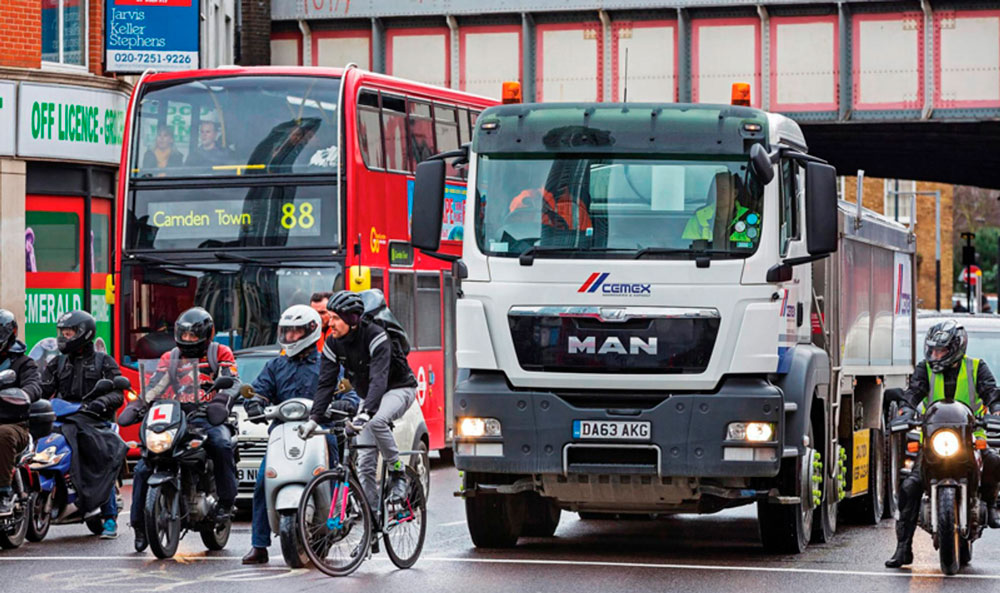
Late last year London’s Mayor Sadiq Khan unveiled plans for a Direct Vision Standard for HGVs operating in the nation’s Capital. The first steps towards it have already been taken.
In September 2016 London Mayor Sadiq Khan announced his intention to introduce the world’s first Direct Vision Standard (DVS) for heavy goods vehicles working in London.
Why direct vision?
Recent research conducted on behalf of Transport for London (TfL) – the local government body responsible for most aspects of London’s transport system and lead organisation for driving the DVS towards final adoption – has shown that truck drivers react more quickly when they can see a cyclist or pedestrian directly through the windscreen or side windows of their cab, rather than when using mirrors or relying on other warning devices. Naturally, the quicker a driver can spot such Vulnerable Road Users (VRUs) the better the chances they have of avoiding a collision with them.
Not surprisingly then, direct vision is at the very heart of the Mayor’s mission to reduce deaths and serious injuries arising from a collision between HGVs and VRUs. And within the original DVS launch document was the proposal to apply a ‘star’ rating system (similar to the New Car Assessment Program or ‘NCAP’ scheme) which rates those trucks with the worst direct vision as ‘0’ and those with the best as ‘5’.
In light of previous studies that also confirmed that the amount of direct vision available to a driver is governed by the height of their driving position (i.e. a high cab generally reduces the ability of a driver to spot VRUs directly in front of the cab as well as within the classic nearside blind-spot area) TfL says: “The largest and highest vehicles, including some ‘off-road’ construction vehicles, and long-haul articulated cabs designed to operate on motorways, are most likely to receive lower or zero-star ratings.”
Conversely, those trucks with low-entry cabs and a lower driving position are seen as scoring up to five stars by virtue of their superior direct vision.
TfL has been in discussions with the vehicle manufacturers for some time as to how to best apply the DVS to trucks used in London. Those talks are on-going. Introducing the standard will also require close working with both the UK Government and the European Commission as well as further consultation with the industry, not least on the likely impact of a DVS on truck operations, road safety and other key issues. Reassuringly, TfL adds:
“A reasonable lead-in period will allow time for necessary adjustments.”
Under its original timetable, TfL was looking to ban (or restrict) those HGVs with a zero star rating from London’s streets from January 2020, while only those trucks with three stars or above would be allowed into London by 2024. However, following consultations this year it has since issued new proposals (see below).
STOP PRESS – DVS LATEST PROPOSALS
This September TfL announced new steps taken towards the adoption of the Direct Vision Standard, including interim DVS star ratings and a proposed new HGV Safety Permit Scheme.
Both will be included in the next DVS consultation due this autumn. TfL says it will continue to work with manufacturers to ensure that interim star ratings for other HGV models will be available later this year. Confirmed star ratings will be published after the forthcoming consultation.
Under the Safer HGV Permit Scheme proposal, by 2020 all HGVs over 12-tonnes would require a safety permit to enter or operate in London. HGVs with a DVS rating of 1-star and above would automatically be granted a permit, while those with 0-star ratings would be granted a permit if they meet specific measures in a ‘safe system.’ TfL says: “The ‘safe system’ will build on best practice from existing, industry-recognised schemes.” Measures could include:
- Sensors and other indirect vision devices
- Audible or visual warning around the vehicle
- Physical protection to deflect vulnerable road users away from the vehicle
- Driver safety training Phase 2 of the scheme, planned for 2024, would require HGVs, rated 2-star and below, to meet the requirements of a ‘progressive safe system’. TfL confirms: “These requirements will be more stringent than those from phase 1 to account for future developments in technology and safety measures, and to give the industry additional time to prepare for these changes. The progressive system will be subject to further consultation at an appropriate point before 2024.”



